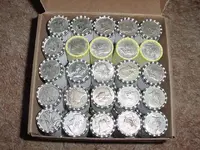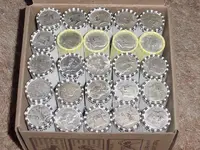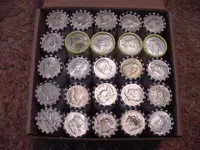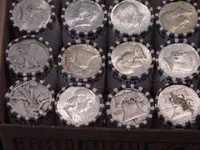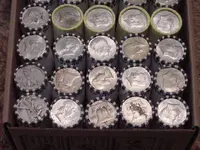Sweet box. statistically, in a box there is on average 10 silver coins for every one silver ender showing (total coins in a box (1000) / [(coins showing per roll (2) x rolls in box (50)] = 10. However, in a normal box if there are 3 silver enders, those 30 likely silvers will be spread throughout an entire box, meaning that an ender roll in your box doesn't represent 10 silver coins, it just represents a box that 10 silver coins from (on average, again). So the problem is, statistically how many silvers should be in your box if a function of the average number of total enders in the boxes they came from. I'll give a few examples. These aren't corrected for the fact that in a given roll after finding one non-ender silver, there are less coins in the roll that can be another silver. but that will complicate things. it just means the percentages for finding a 2nd and 3rd non-ender silver in a roll are slightly high (by about a tenth)
assuming each roll was the only ender in the box they came from:
Avg. Total Non-ender Silver in Box = 9
# of rolls they can be in = 50
Chances of a roll containing a non-ender silver = 18% or (9/50) *100
Chances of a roll containing 2 non-ender silvers = 2.8% or (9/50)*(8/50) *100
Chances of a roll containing 3 non-ender silvers = 0.4% or (9/50)*(8/50)*(7/50) *100
Chances of a roll containing 4 non-ender silvers = 0.04% or (9/50)*(8/50)*(7/50)*(6/50) *100
Now let's look at an ender roll that came from a box with 2 ender rolls total
Avg. Total Non-ender Silver in Box = 18
Chances of a roll containing a non-ender silver = 36% or (18/50) *100
Chances of a roll containing 2 non-ender silvers = 12.2% or (18/50)*(17/50) *100
Chances of a roll containing 3 non-ender silvers = 3.9% or (18/50)*(17/50)*(16/50) *100
Chances of a roll containing 4 non-ender silvers = 1.2% or (18/50)*(17/50)*(16/50)*(15/50) *100
See, it really depends! let's say that half your rolls Came from boxes with 1 ender and half your rolls came from boxes with 2 enders, just to be safe. Now the percentages are 27% (1 non-ender silver), 6.7 % (2 non-ender silvers), 1.5% (3 non-ender silvers), and 0.3% (4 non-ender silvers) So, here are the statistics of each roll, making a couple minor assumptions
% of rolls with no additional silver = 64.5%
% of rolls with silver = 35.5%
Avg. # of silver coins in roll in addition to ender coin =
1*.27 + 2*.067 + 3*.015 + 4*.003 = .461
so, about every other roll will contain an additional silver (on average. in reality you will likely find several rolls in a roll with none and/or rolls with several additional silver). Because there is a guaranteed 1 silver coin in each roll, there will be, on average, 1.461 silver coins per roll. times 50 rolls means
you are most likely to find 73 silver coins in the box. <----skip to here if you don't care about the math

Because you are showing 2 walkers (4% of enders), 6 bens (12%), 4 64's (8%), and 38 40%ers (76%), that breaks down to
Average likely finds:
Walkers: 2.9 (or 1 more than what's showing probably)
Bens: 8.76 (so 2 - 3 more than what's showing)
1964's: 5.84 (1-2 more than showing)
40%ers: 55.48 (17-18 more than showing)
For a total of 17.5 90%ers and 55.48 40%ers, you are likely to find
14.52 OZ . At a spot of 19.83 that's $288.29. Subtracting the face value of silver the silver profit would be
$251.79
So i guess you'd want to make at least $750 on the box if it's going to be worth selling. just sayin'
Keep in mind that averages are often way off. Like the old saying that if you tailor a suit to the average size of 100 people, it will fit none of them. The 90% averages will be further off than the 40% averages since the sample size is smaller. I hope you strike it big




